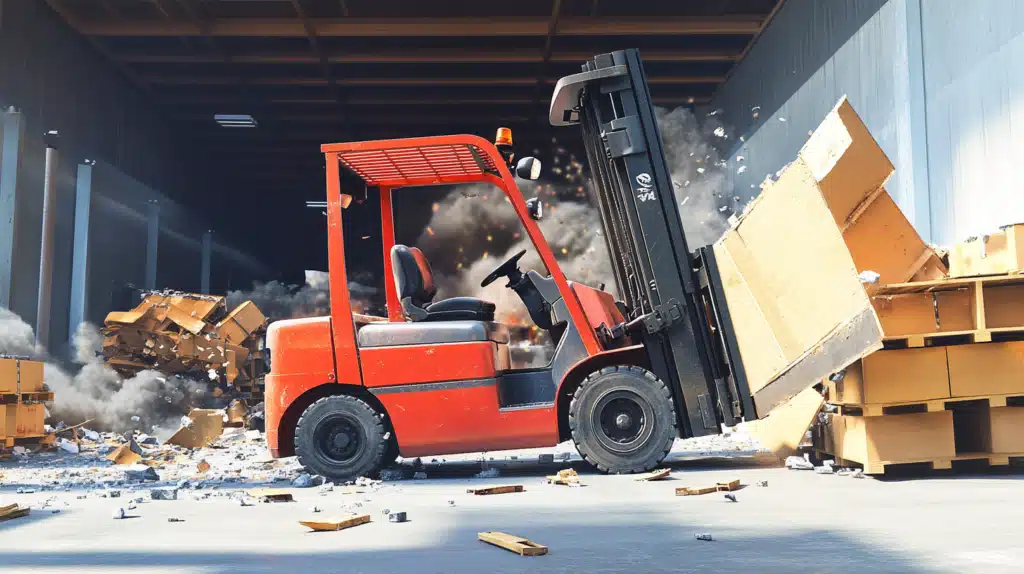Forklifts are an essential part of many industries, from warehouses to construction sites, helping to move heavy loads efficiently. However, they also pose significant risks if not handled properly. Inadequate training, poor maintenance, and unsafe practices can lead to serious accidents, resulting in injuries, fatalities, and costly damages.
In this blog post, we will explore 10 common forklift accidents and explain how proper training can help prevent them.
Forklift Overturns
Cause:
One of the leading causes of forklift-related fatalities is tip-overs. This can occur due to excessive speed, carrying an unbalanced load, taking sharp turns, or driving on uneven surfaces.
Prevention:
- Proper load balancing and secure placement of materials.
- Avoiding sudden movements or sharp turns.
- Training operators to maintain safe speeds and recognize hazardous surfaces.
Collisions with Pedestrians

Cause:
Forklifts often operate in areas with workers walking nearby. Poor visibility, distractions, or lack of awareness can result in collisions.
Prevention:
- Implementing designated pedestrian walkways and forklift-only zones.
- Using warning signals such as horns, flashing lights, or alarms.
- Training operators to always check blind spots before moving.
Load Falls Off the Forks
Cause:
Loads that are improperly secured or imbalanced can slip off, potentially injuring nearby workers or damaging property.
Prevention:
- Ensuring proper stacking and load securing techniques.
- Training on the correct load weight capacity for different forklifts.
- Performing pre-lift stability checks.
Forklift Tipping Forward or Backward
Cause:
Lifting a load that exceeds the forklift’s weight capacity or improper positioning of the load can cause tipping.
Prevention:
- Never exceed the manufacturer’s weight limit.
- Keep the load as low as possible while traveling.
- Operators should be trained to distribute weight properly.
Reckless or Speeding Operators
Cause:
Some forklift operators, especially those with little experience, may drive too fast or make sudden stops and turns, increasing the risk of accidents.
Prevention:
- Strict enforcement of speed limits in warehouses and work areas.
- Training to emphasize controlled driving and hazard awareness.
- Installing speed control systems on forklifts.
Driving with Elevated Loads
Cause:
Carrying loads at an elevated height while moving reduces visibility and increases the risk of tipping.
Prevention:
- Training to keep loads low while traveling.
- Always check surroundings before lifting or lowering loads.
- Using spotters when maneuvering in tight spaces.
Lack of Pre-Operational Inspections
Cause:
Failure to conduct daily forklift inspections can lead to malfunctions, such as brake failures or hydraulic leaks, resulting in accidents.
Prevention:
- Daily pre-shift inspections to check brakes, lights, steering, and other key components.
- Training operators on recognizing early warning signs of mechanical failures.
- Implementing a scheduled maintenance program.
Inadequate Workplace Safety Measures
Cause:
Forklifts operating in poorly maintained or cluttered environments can lead to accidents such as slips, falls, or collisions.
Prevention:
- Keeping aisles clear of obstructions.
- Ensuring proper warehouse lighting for visibility.
- Training operators to report hazards immediately.
Improper Parking of Forklifts
Cause:
Leaving a forklift improperly parked, such as on an incline or with forks raised, can lead to rollaways or unintended movements.
Prevention:
- Always engage the parking brake when stopping.
- Keep forks lowered to the ground when parked.
- Training on proper shutdown procedures.
Forklift Operator Fatigue
Cause:
Long shifts, poor rest, and lack of focus can cause slow reactions, leading to misjudgments and accidents.
Prevention:
- Ensuring adequate breaks during shifts.
- Training operators on the importance of staying alert.
- Encouraging workers to report fatigue and avoid operating forklifts when tired.
Why Proper Forklift Training is Essential
Comprehensive forklift training programs are crucial in preventing these accidents. Training should include:
- Operating Procedures – Understanding the mechanics of forklift operation.
- Safety Guidelines – Awareness of workplace hazards and safe driving practices.
- Load Handling – Proper techniques for stacking and moving loads.
- Emergency Procedures – Knowing what to do in case of an accident.
Investing in proper training not only ensures compliance with workplace safety regulations but also significantly reduces injury risks, equipment damage, and operational costs.
Final Thoughts
Forklifts are indispensable in many industries, but without proper training and safety measures, they can become dangerous tools. Employers should prioritize ongoing training and workplace safety improvements to prevent accidents and create a safer work environment.
















